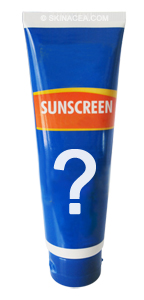How to Choose the Right Sunscreen
5 things to look for in a great sunscreen |

Many people think that using moisturizer or foundation with SPF is enough protection from the sun. However, this is incorrect. SPF included in these products is usually not very stable and does not provide adequate protection on its own. You also probably don't use enough moisturizer or SPF makeup to get sufficient sun protection. Therefore, it's best to use a moisturizer without SPF and a separate sunscreen afterwards.
The process of finding your holy grail sunscreen can be confusing. Like treating acne, it's all about trial and error. However, you can make the process of looking for a good sunscreen a little bit easier by taking the following 5 things into consideration: photostability, broad-spectrum protection, potential irritation, cosmetic finish, and cost and availability. This will give you the best chance at choosing the right sunscreen for your skin.
Photostability:
You want to choose a sunscreen that is photostable, which means it won’t break down when exposed to light. If a sunscreen is photounstable, it will destabilize or degrade when you walk out the door and not provide enough protection from UV rays. Physical UV filters are photostable, as well as a number of chemical filters. However, some chemical filters, such as avobenzone, are highly unstable. To learn how to tell if your sunscreen is photostable, check here.Broad-Spectrum Protection:
 Broad-spectrum protection means that a sunscreen protects against both UVA and UVB rays. It isn’t enough to just protect against one of the UV rays, because if you protect against UVB rays, you will still get damage from UVA rays and vice versa. Therefore, it is important to select a sunscreen with broad-spectrum protection.
Broad-spectrum protection means that a sunscreen protects against both UVA and UVB rays. It isn’t enough to just protect against one of the UV rays, because if you protect against UVB rays, you will still get damage from UVA rays and vice versa. Therefore, it is important to select a sunscreen with broad-spectrum protection.
How do you know if your sunscreen is broad-spectrum? Well, skin care companies will usually have the words “broad-spectrum” labeled on their products. However, just because a sunscreen has this label doesn’t mean it protects against 100% of all UVA and UVB rays.
Instead of looking for the words “broad-spectrum”, it is better to look at a sunscreen’s SPF and PPD. SPF (sun protection factor) measures how well a sunscreen protects against UVB rays, while PPD (persistent pigment darkening) measures how well a sunscreen protects against UVA rays. Therefore SPF will help prevent sunburns, while PPD guards against photoaging. For more information on SPF and PPD, check here.
SPF has been in the limelight for some time now and many people erroneously assume that if they use a sunscreen with a high SPF, they are adequately protecting themselves from the sun. However, even if a sunscreen has a high SPF, being well-protected against UVB rays isn’t enough. What about all the UVA rays that are making it to your skin?
That’s why it’s also important to consider PPD. PPD has a numerical value and the higher the number, the better the UVA protection it offers. In some countries, PPD is also known as PA with plus signs (ex. PA+++) that represent the strength of the sun coverage. Again, the more plus signs the better. However, there is no international standard for measuring how well UV filters protect against UVA rays, so the way PPD and PA values are determined may differ from company to company and country to country.
Because of this ambiguity in measurement, PPD values can only be estimated. Some sunscreens don’t even have PPD written on their label, but you can figure out the PPD numbers by doing some sunscreen ingredient sleuthing and using this convenient online calculator.
For everyday use, my dermatologist recommends using a sunscreen with a minimum of SPF 15 but says that it would be even better if it was SPF 30+. For days when you know you will be out in the sun for longer hours, it’s best to bump it up to SPF 40+. Also, look for a sunscreen with a PPD of around 8 (preferably higher) for decent UVA protection. If your skin is quite fair, you may need a stronger sunscreen as well.
Keep in mind that a sunscreen with good SPF and good PPD numbers will only be effective if the sunscreen is photostable and applied correctly to your skin.Minimal irritation, breakouts, and/or dryness:
After narrowing down a sunscreen that is both photostable and broad-spectrum, the next step is to find one that does not irritate your skin. The main complaints most people have about sunscreen are that it can 1) sting their skin, 2) cause breakouts, and/or 3) be too drying.
If sunscreen stings your skin or turns it red, you may want to switch to an all physical sunscreen. Chemical UV filters tend to be more irritating than physical UV filters. On the other hand, if you experience breakouts from a sunscreen, it could be because you are sensitive to one or more of the UV filters (i.e. titanium dioxide) or whatever inactive ingredients (i.e. emollients) are used for the sunscreen base.
Most sunscreens have a high alcohol content to make them feel less greasy. If your skin is feeling too dry with a sunscreen, you could try looking for a sunscreen with less alcohol (with alcohol listed lower on the ingredient list) or apply a good moisturizer before putting on your sunscreen.
However, the only way to tell how a sunscreen will react with your skin is by using it. Consult online reviews to get an idea of which sunscreens are well-tolerated and how people have responded to them, but everyone’s skin is different. You won’t know until you try it out for yourself! Here is a list of different sunscreen brands and their respective UV filters to help you out.Cosmetically Elegant Finish:
Remember all the coconut-smelling, greasy sunscreens we used as kids? I can’t imagine putting something like that on my skin, much less my face! Thankfully, sunscreens today are much better formulated. They smell nicer (or are fragrance free) and feel better.
However, because of the nature of UV filters, it’s still rather complicated to make a sunscreen with a cosmetically elegant finish. The main complaints people have about how a sunscreen feels include: 1) leaving a white cast after application, 2) feeling too greasy or heavy, 3) feeling too dry, and/or 4) balling up when applying makeup afterwards.
There are a few things you can do to make a sunscreen feel better though. The white cast problem will usually go away after you let the sunscreen completely absorb. However, that can take up to 2 hours or more and most people don’t have that kind of time when they are getting ready for work or school in the morning! Applying sunscreen in a patting motion instead of a rubbing motion can also help prevent makeup from balling up.
You just have to go through trial-and-error to see which sunscreen feels best. Most likely, even with the best formulated sunscreens, you’re still going to be able to “feel” something your skin. Just make sure the feel of the sunscreen is something you can tolerate wearing everyday. Look for a sunscreen with a good finish that does not compromise good protection.Cost and Availability:
 How much a sunscreen costs and whether you can easily get your hands on it are other things to consider. Some of the better formulated or more protective sunscreens can be quite expensive, so choose a sunscreen that won’t make too large of a dent in your wallet!
How much a sunscreen costs and whether you can easily get your hands on it are other things to consider. Some of the better formulated or more protective sunscreens can be quite expensive, so choose a sunscreen that won’t make too large of a dent in your wallet!
I tend to spend more money on sunscreens formulated for the face than the body because my facial skin is very finicky. Some days it'll be happy with anything I put on it, while other days it just freaks out for no reason. I find that most facial sunscreens have a better feel, but if your skin can handle it, I see no problem with using body sunscreens on your face. Some sunscreens don't even have labels that distinguish them from face or body use, so it just depends on how your skin likes the sunscreen. I personally am more careful because of my very acne-prone skin.
Most of the superior sunscreens are also not available in the US, but only obtainable through Europe or Asia. This is because some of the UV filters used in European and Asian sunscreens have not been approved by the FDA. However, you can still find good sunscreens at the drug store or makeup counter.
You can also purchase these sunscreens online (shipping may be expensive) or whenever you visit countries in these regions. Just be aware that purchasing sunscreens with illegal ingredients is considered circumventing the law. Although customs probably won’t bother with small packages, some people have had their international orders seized.
When it comes to choosing a good sunscreen, it all boils down to using something your skin likes and something that isn’t too big of a hassle to buy, even if the sunscreen doesn’t offer the best protection.
For example, if you’re trying to get the maximum sun protection possible but you end up looking like a broken out, greasy Casper, it really isn’t worth it. The way I like to think of it is, would I rather dread and hate putting on sunscreen every single day of my life? Or would I rather use a sunscreen that’s maybe not as good, get a few wrinkles and sun damage here and there, but ultimately be happy with how my skin feels every day? Choosing a sunscreen can seem overly scientific, but that doesn’t mean it has to be illogical.
Besides choosing a photostable, broad-spectrum, good-feeling sunscreen, it is also important to know how to wear sunscreen the right way to get the maximum amount of protection. Did you know you have to wait 30 minutes after applying some sunscreens before going outside? Do you put enough sunscreen on your face for the sunscreen to be effective?
Read here for more information about proper sunscreen application.
Last updated: September 12, 2012
Related articles:
